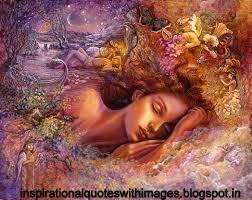What Dreams Mean
Dreams are successions of images, ideas, emotions and sensations occurring involuntarily in the mind during certain stages of sleep. The content and purpose of dreams are not definitively understood, but they have been a topic of scientific speculation, as well as a subject of philosophical and religious interest throughout recorded history. The scientific study of dreams is called Oneirology. Scientists believe that, in addition to humans, birds and other mammals also dream.
Dreams mainly occur in the phase of rapid eye movement sleep when brain activity is high and resembles that of being awake. REM sleep is characterized by continuous movements of the eyes during sleep. Sometimes, dreams may occur during other stages of sleep. However, these dreams tend to be much less vivid or memorable.
Dreams can last for a few seconds, or as long as twenty minutes. People are more likely to remember the dream if they are awakened during REM sleep. The average person has three to five dreams per night, but some can be up to seven dreams in one night. Dreams tend to last longer than the night progress. During a full night's sleep eight hours, two hours of dream that it is spent.
 |
| Dreams |
In modern times, dreams were seen as a connection to the unconscious. They range from normal and ordinary too surreal and strange. Dreams can have different natures, as frightening, exciting, magical, melancholic, adventurous, or sexual. Events in dreams are generally outside the control of the dreamer, with the exception of lucid dreaming, where the dreamer is self-aware. Dreams can sometimes make a creative thought occur to the person or give a sense of inspiration.
Opinion on the meaning of dreams have varied and shifted through time and culture. Interpretation of dreams dating back to 5000-4000 BC. The earliest recorded dreams were acquired from materials dating back approximately 5000 years, in Mesopotamia, where they were documented on clay tablets. In the Greek and Roman periods, the people believed that dreams are messages from the gods or from the dead, and they predicted the future. Some cultures practiced dream incubation with the intention of cultivating dreams that are prophetic.
Sigmund Freud, who developed the discipline of psychoanalysis, wrote extensively on the theories and interpretations of dreams. He explained dreams as manifestations of our deepest desires and anxieties, often relating to repressed childhood memories or obsessions. In The Interpretation of Dreams, Freud developed a psychological technique to interpret dreams and devised a series of guidelines to understand the symbols and motifs that appear in our dreams
 |
| Dreams And Meanings |
Ancient history
 |
| Recurring Dreams |
The Dreaming is a common term in the animist creation narrative of indigenous Australians for a personal, or group, creation and for what may be regarded as the "timeless time" of formative creation and perpetual creating .The Sumerians in Mesopotamia left evidence of dreams dating back to 3100 BC. According to these early recorded stories gods and kings, like the 7th century BC scholar-king Assurbanipal, paid particular attention to dreams. In his archive of clay tablets, some amounts of the story of the legendary king Gilgamesh were found. The Mesopotamian believed that the soul, or part of it, moves out from the body of the sleeping person and actually visits the places and persons the dreamer sees in his sleep. Sometimes the god of dreams is said to carry the dreamer. Dreams Babylonians and Assyrians divided into "good", which were sent by the gods, and "bad", sent by demons - They also believed that their dreams were omens and prophecies.
In ancient Egypt as far as 2000 BC the Egyptians wrote down their dreams on papyrus. People who have vivid dreams and important were thought blessed and were considered special. The ancient Egyptians believed that dreams are like oracles, bringing messages from the gods. They thought the best way to receive divine revelation was through dreaming and thus they induce (or "incubate") dreams. Egyptians went to the shrines and beds to sleep on special "dream" in the hope of receiving advice, comfort, or healing from the gods.
The story Classical Interesting Facts About Dreams
Dreaming of the Tiger Spring In Chinese history, people have written two essential aspects of the soul which one is freed from the body during sleep to travel to a dream world, while the other remained in the body, although this belief and the interpretation of dreams was questioned from time immemorial, as the philosopher Wang Chang The Upanishads Indian text, written between 900 and 500 BC, emphasize two meanings on dreams. The first says that dreams are merely expressions of inner desires. The second is the belief of the soul leaving the body and being guided until awakened.
 |
| Ancient Dreams And Meaning |
The Greeks shared their belief with the Egyptians on how to interpret dreams good and bad, and the idea of incubating dreams. Morpheus also sent warnings and prophecies to those who slept at shrines and temples. The first Greek beliefs of dreams was that their gods physically visited the dreamers, where they entered through a keyhole, and exiting the same way after the divine message was given.
Antiphon wrote the first known Greek book on dreams in the 5th century BC. In this century, the influence of other cultures Greeks developed the belief that souls left the sleeping body. Hippocrates had a simple dream theory: During the day, the soul receives images during the night, it produces images. Greek philosopher Aristotle (384-322 BC) believed dreams caused physiological activity. He thought dreams could analyze illness and predict diseases. Marcus Tullius Cicero, for his part, believes that all dreams are produced by the thoughts and conversations had a dream during the days that preceded it.
In the Abrahamic religions
Jacob dreams of a ladder of angels, c. 1690, by Michael Willmann In Judaism, dreams are considered part of the experience of the world can be interpreted and that lessons c.an be collected from. It is discussed in the Talmud, Tractate Berachot, second. The ancient Hebrews connected their dreams heavily with their religion, though the Hebrews were monotheistic [citation needed] and believed that dreams were the voice of one god alone. Hebrews also differentiated between good dreams (from God) and bad dreams (from evil spirits). The Hebrews, like many other ancient cultures, incubated dreams in order to receive divine revelation. For example, the Hebrew prophet Samuel, would "lay down and sleep in the temple at Shiloh before the Ark and receive the word of the LORD." Most dreams are in the Bible in the book of Genesis.
Most Christians have shared their beliefs with the Hebrews and thought that dreams were of the supernatural element because the Old Testament had frequent stories of dreams with divine inspiration. The most famous of these dream stories was Jacob's dream that stretched from Earth to Heaven. Many Christian men preached that God talked to his people through their dreams. Iain R. Edgar has studied the role of dreams in Islam. He argued that dreams play an important role in the history of Islam and Muslim life. Ishtikara, or the interpretation of dreams is the only way Muslims can receive revelations from God after the death of the last Prophet Muhammad.
Dreams and philosophical realism
Some philosophers have concluded that what we think of as the "real world" could be or is an illusion (an idea known as the skeptical hypothesis about ontology). The first mention of the idea was Zhuangzi, and it is also discussed in Hinduism which makes extensive use of the argument in its writings. It was officially presented to Western philosophy by Descartes in the 17th century in his Meditations on First Philosophy. Stimulation, usually one audience becomes part of a dream, eventually then awakening the dreamer.
The history of post-classical and medieval
 |
| Interpreting Dreams |
Some indigenous tribes of America and Mexican civilizations believe that dreams are a way of visiting and having contact with their ancestors.Some Native American tribes used vision quests as a rite of passage, fasting and praying until anticipated guiding dream that has been received, to share with the rest of the tribe upon their return.
The Middle Ages brought a harsh interpretation of dreams. They were considered evil, and images temptations of the devil. Many believed that during sleep, the devil could fill the human mind with thoughts corrupt and harmful. Martin Luther, founder of Protestantism, believed dreams were the work of the devil. However, Catholics as St. Augustine and St. Jerome claimed that the direction of their life were heavily influenced by their dreams.
In art
Dark dreams and imaginations are the theme of Goya's etching The Sleep of Reason Produces Monsters. There is a picture of Salvador Dalí, which illustrates this concept, titled Dream Caused by the Flight of a Bee around a Pomegranate a Second Before Awakening (1944). Rousseau's last painting was the dream. The Dream ("The Dream") is a 1932 painting by Pablo Picasso.
 |
| vivid dreams |
In the literature
Frameworks dreams were frequently used in medieval allegory to justify the narrative, The Book of the Duchess and Piers Plowman vision are two such dream visions. Even before them, in antiquity, the same device was used by Cicero and Lucian.
They have also featured in fantasy and speculative fiction since the 19th century. A dream worlds most famous is Wonderland by Lewis Carroll Alice in Wonderland, as well as research and Glass Land from its sequel, Through the Looking Glass. Unlike many dream worlds, Carroll's logic as that of actual dreams, with transitions and causality flexible.
Other fictional dream worlds include the Dreamlands of HP Lovecraft's Dream Cycle and The Neverending Story world of Fantasia, which includes places like the Desert of Lost Dreams, the Sea of opportunities and swamps of sadness. Dreamworlds, shared hallucinations and other alternate realities feature in a number of works by Phillip K. Dick, as Stigmata of Palmer Eldritch and Ubik three. Similar themes were explored by Jorge Luis Borges, for instance in The Circular Ruins